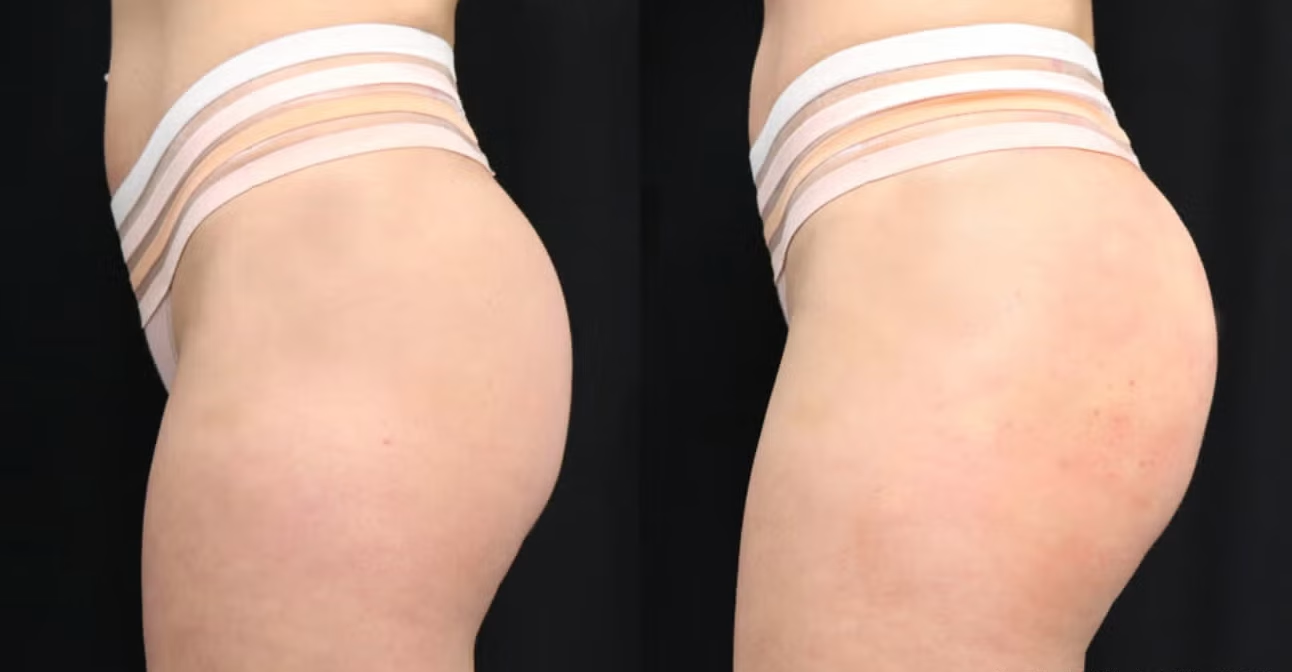
Sculptra works by stimulating collagen production gradually, not by adding immediate volume through a filler. The injected product is poly-L-lactic acid, not a gel-based filler. It encourages your body to form collagen around the injection site over weeks. Volume appears subtly over time as the body responds naturally. Most patients need multiple sessions spaced several weeks apart for visible improvement. Final results can take months but last longer than many alternatives. This method doesn’t offer instant results, but rather a progressive transformation. It suits those wanting gradual changes without a dramatic overnight effect.
Hyaluronic acid provides instant volume by filling the space with a dense, gel-like substance
Hyaluronic acid provides instant volume by filling the space with a dense, gel-like substance. This is the same molecule used in facial fillers but adjusted for body use. It creates immediate contour by occupying space under the skin. Results are visible right after the procedure and continue to refine as swelling subsides. However, hyaluronic acid doesn’t stimulate new tissue—it only adds temporary bulk. Depending on the product used, results last from six to twelve months. For patients needing quick, defined improvement, this option offers predictability and convenience. Repeat treatments are necessary to maintain shape.
Sculptra may require three to four sessions, while hyaluronic acid often achieves results in one appointment
Sculptra may require three to four sessions, while hyaluronic acid often achieves results in one appointment. The body takes time to respond to collagen stimulation. Sculptra sessions are spaced weeks apart, requiring patience and long-term planning. HA injections offer a one-time solution with faster results but less durability. Your treatment timeline depends on how quickly you want to see changes. Scheduling multiple appointments may not suit everyone. But for lasting outcomes, Sculptra is often the longer-term strategy. The process feels more like investing in your own biology, rather than just filling space.
Sculptra results can last two years or more, while hyaluronic acid dissolves within one year or less
Sculptra results can last two years or more, while hyaluronic acid dissolves within one year or less. Longevity makes a key difference between the two methods. Sculptra’s collagen build-up remains stable long after the product fades. HA breaks down faster and is reabsorbed by the body. Patients often need touch-ups sooner with HA-based enhancements. For those wanting extended results with fewer appointments, Sculptra has an advantage. However, HA offers flexibility for those uncertain about permanent volume. One is more of a commitment, the other suits short-term experimentation.
Hyaluronic acid is reversible with an enzyme injection, while Sculptra cannot be easily dissolved once injected
Hyaluronic acid is reversible with an enzyme injection, while Sculptra cannot be easily dissolved once injected. If complications or dissatisfaction occur, HA can be broken down with hyaluronidase. Sculptra requires the body to metabolize it naturally over months. This difference affects how patients feel about reversibility and risk. Those concerned with outcome control may lean toward HA for peace of mind. With Sculptra, once injected, your body begins integrating it. That biological process isn’t easily reversed. Understanding this helps patients weigh risk tolerance alongside desired longevity.
The amount of product needed varies—Sculptra typically uses fewer vials than hyaluronic acid for comparable lift
The amount of product needed varies—Sculptra typically uses fewer vials than hyaluronic acid for comparable lift. HA is dense and requires more volume to create visible projection. Sculptra’s gradual collagen stimulation builds structure using smaller amounts per session. Costs per vial vary, but overall budgets may even out across time. Many patients require 10–20 syringes of HA compared to fewer vials of Sculptra. Discussing expected product amounts with your provider is essential for proper planning. The number of vials directly affects pricing and treatment scheduling.
Both options carry risks, but HA tends to have fewer long-term complications due to its reversibility
Both options carry risks, but HA tends to have fewer long-term complications due to its reversibility. Common issues include swelling, bruising, and asymmetry after injection. Sculptra may also cause nodules or overcorrection if not properly diluted or massaged. HA complications are usually temporary and can be corrected with enzymes. Sculptra reactions are slower to resolve due to collagen stimulation continuing post-treatment. A skilled injector reduces risk with correct placement and volume control. Safety depends more on experience than product choice alone. Choose a provider familiar with both techniques and anatomy.
Skin texture and quality can improve more with Sculptra since collagen formation supports firmness and elasticity
Skin texture and quality can improve more with Sculptra since collagen formation supports firmness and elasticity. While HA adds shape, it doesn’t affect skin health directly. Sculptra strengthens the dermal layer, reducing the appearance of dimples or irregularities. This makes it appealing to patients with aging or uneven skin. Over time, the tissue becomes more resilient due to internal collagen scaffolding. HA provides surface contour but doesn’t remodel the underlying tissue. Sculptra’s benefits extend beyond volume, offering a broader aesthetic improvement across treated zones.
Hyaluronic acid works well for targeted shaping, while Sculptra is better for overall volume and gradual build
Hyaluronic acid works well for targeted shaping, while Sculptra is better for overall volume and gradual build. HA allows for precise contouring in small areas like hip dips. It’s excellent for patients wanting to tweak specific shapes without global changes. Sculptra fills larger areas by encouraging collagen evenly over the region. That makes it ideal for fuller buttocks enhancement or subtle reshaping. The decision depends on whether you want sculpting or generalized projection. Some providers even combine both methods for optimal customization.
Choosing between them depends on your timeline, goals, budget, and comfort with gradual versus immediate change
Choosing between them depends on your timeline, goals, budget, and comfort with gradual versus immediate change. Some patients value fast results before an event. Others prefer investing in subtle, slow-building transformation. HA offers predictability and reversibility; Sculptra offers longevity and tissue health. Budget varies depending on quantity needed and number of visits. Your provider should assess your anatomy and listen to your expectations before recommending. There’s no universally better choice—only what fits your body and mindset.
